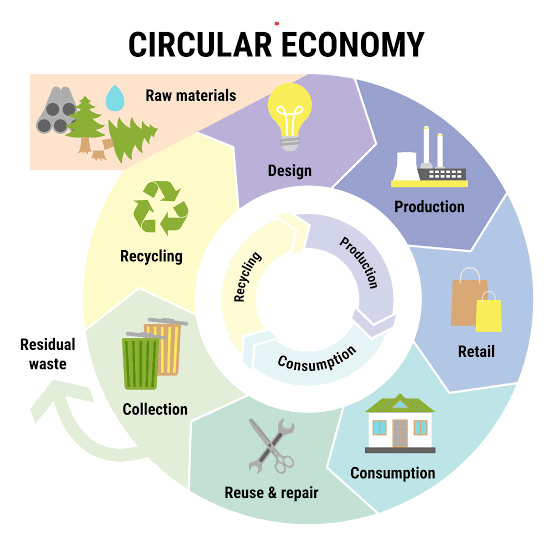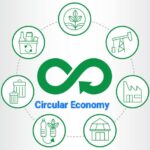~By Abhishek Kumar
Introduction
The linear “take-make-dispose” model of production and consumption has significantly contributed to resource depletion, environmental degradation, and increasing waste generation (Sharma et al., 2020; Kumar & Mehta, 2021). The Circular Economy (CE) model, by contrast, seeks to close the loop by promoting the recycling, reuse, and recovery of materials, aiming to keep resources in use for as long as possible (Ellen MacArthur Foundation, 2020; Singh et al., 2019). This transition can result in reducing environmental footprints while creating new economic opportunities (Bocken et al., 2016). According to the European Commission (2020), the Circular Economy Action Plan is a vital step toward achieving sustainability goals by minimizing waste and encouraging more sustainable production methods. The role of effective waste management in the CE model is critical, enabling the transformation of waste into valuable resources ( Geissdoerfer et al., 2017).
Globally, these practices can generate significant economic benefits, including job creation, economic growth, and enhanced resilience (Kirchherr et al., 2018; Stahel, 2016). As countries adopt CE frameworks, understanding the synergies between waste management and CE is essential for scaling up circular practices. This paper examines the strategies and innovations that align waste management with the goals of a circular economy, with a focus on emerging technologies and global case studies (Lieder & Rashid, 2016; Van Buren et al., 2016).
Circular Economy Concept
1. Circular Economy and Its Role in Waste Management:
Circular economy (CE) principles are grounded in minimizing waste, maximizing the lifecycle value of products, and reducing resource consumption ( Geissdoerfer et al., 2017; Bocken et al., 2016). Waste management plays a vital role in Circular Economy, where the goal is to divert waste from landfills and transform it into reusable resources (Sharma et al., 2020). In industries such as electronics, automotive, and packaging, the design of products for longevity, repair ability, and recyclability is key to supporting CE objectives (Kumar & Mehta, 2021; Ellen MacArthur Foundation, 2020).
One of the most effective strategies is the implementation of closed-loop recycling systems, where products are designed with their end-of-life in mind, reducing the need for new raw materials (Van Buren et al., 2016). This approach can reduce both environmental impacts and operational costs, leading to a more sustainable economy (Singh et al., 2019; Sharma et al., 2020).
2. Technological Innovations:
Advancement in technologies have been pivotal in improving waste management systems and facilitating the circular economy. Innovations such as Waste-to-Energy (WTE) technologies, including anaerobic digestion and gasification, are helping convert organic waste into bioenergy, reducing landfill dependency (Zhao et al., 2018; Kumar & Mehta, 2021). These technologies not only recover valuable resources but also generate renewable energy, contributing to the energy transition (Bocken et al., 2016).
Other than this, Material Recovery Facilities (MRFs) equipped with AI and automation technologies improve waste sorting processes, enhancing recycling efficiency and reducing contamination rates (Lieder & Rashid, 2016; Ellen MacArthur Foundation, 2020). Smart waste management systems utilizing IoT sensors and data analytics help optimize collection routes and monitor waste streams, thus increasing operational efficiency (Sharma et al., 2020).
3. Global Case Studies:
Global examples demonstrate the practical applications of CE principles in waste management. Japan’s Eco-Towns are notable for their industrial symbiosis model, which encourages industries to share by-products and reduce waste through mutual exchanges (Kirchherr et al., 2018). Similarly, Sweden has adopted a highly efficient waste management system, where over 99% of household waste is recycled or converted into energy, significantly reducing reliance on landfills (Stahel, 2016).
In India, the Extended Producer Responsibility (EPR) policy framework for plastic waste management has made strides toward reducing plastic waste through accountability measures placed on manufacturers to manage the disposal of their products (Singh et al., 2019; Sharma et al., 2020).
4. Recent Trends in Sustainable Waste Management:
Recent trends indicate growing interest in urban mining, where valuable materials are recovered from e-waste and old infrastructure, reducing the need for virgin materials and promoting sustainable production (Zhao et al., 2018). Circular bioeconomy practices, particularly in the agricultural sector, are gaining momentum as agricultural and food waste are being repurposed into bio-based materials, chemicals, and fertilizers (Lieder & Rashid, 2016; Kumar & Mehta, 2021).
Furthermore, Zero-Waste movements are being increasingly adopted by cities like San Francisco and Kamikatsu, Japan, which aim for near-total diversion of waste from landfills through extensive recycling and composting efforts ( Geissdoerfer et al., 2017; Ellen MacArthur Foundation, 2020).
5. Policy Interventions:
Policy frameworks are critical in scaling up the circular economy. The European Union’s Circular Economy Action Plan outlines measures to reduce waste, boost recycling rates, and promote sustainable consumption patterns (European Commission, 2020). The National Sword Policy in China, which bans the import of contaminated recyclable materials, has forced other countries to enhance their domestic recycling capabilities (Kirchherr et al., 2018). Policies such as these are integral to fostering a global transition toward circular systems.
Conclusion:
The integration of waste management practices into the circular economy offers a promising pathway to reduce environmental degradation, improve resource efficiency, and foster economic growth. By leveraging technological innovations, scaling up best practices, and promoting robust policy frameworks, the circular economy can significantly mitigate the adverse effects of waste while creating new opportunities for industries and communities. However, to realize this potential, continued efforts in collaboration, technology, and policy implementation are essential.
References:
- Bocken, N. M. P., Short, S. W., Rana, P., & Evans, S. (2016). A literature and practice review to develop sustainable business model archetypes. Journal of Cleaner Production, 65, 42-56.
- Ellen MacArthur Foundation. (2020). The Circular Economy Advantage. Retrieved from https://www.ellenmacarthurfoundation.org
- European Commission. (2020). Circular Economy Action Plan. Retrieved from https://ec.europa.eu/environment/circular-economy
- Geissdoerfer , M., Savaget, P., Bocken, N. M. P., & Hultink, E. J. (2017). The circular economy – A new sustainability paradigm? Journal of Cleaner Production, 143, 757-768.
- Kirchherr, J., Reike, D., & Hekkert, M. (2018). Conceptualizing the circular economy: An analysis of 114 definitions. Resources, Conservation and Recycling, 127, 221-232.
- Kumar, R., & Mehta, P. (2021). Sustainable waste management practices in India: Current trends and challenges. Waste Management, 119, 119-130.
- Lieder, M., & Rashid, A. (2016). Towards circular economy implementation: A comprehensive review in the context of manufacturing industry. Journal of Cleaner Production, 115, 36-51.
- Sharma, A., Kapoor, P., & Gupta, R. (2020). Circular economy strategies for sustainable development: The role of waste management. Environmental Science and Pollution Research, 27, 12123-12132.
- Singh, A., Purohit, A., & Yadav, M. (2019). Circular economy practices and their implications for sustainable waste management. Waste Management & Research, 37(6), 516-527.
- Stahel, W. R. (2016). The circular economy: A user’s guide. Routledge.
- Van Buren, N., Demmers, M., Van der Heijden, R., & Witlox, F. (2016). Circular business models: A review. Journal of Cleaner Production, 114, 28-41.
- Zhao, J., Wang, W., & Song, M. (2018). Emerging technologies in waste-to-energy systems: A review. Journal of Environmental Management, 219, 306-318.







